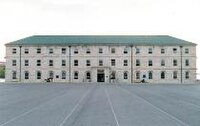Rush–Bagot Treaty
The treaty provided for a large demilitarization of lakes along the international boundary, where many British naval arrangements and forts remained.The remaining Great Lakes permitted the United States and British North America to keep two military vessels "of like burden" on the waters armed with "like force".The United States and Canada agreed in 1946, through an exchange of diplomatic notes, that the stationing of naval vessels for training purposes was permissible provided each government was fully notified in advance.Similar problems occurred before World War II, but Secretary of State Cordell Hull wanted to preserve the agreement because of its historical importance.After discussions in the Permanent Joint Board on Defense, in 1946, Canada similarly proposed to interpret the agreement as permitting using ships for training purposes if each country notified the other.




Washington, D.C.Arms controlWar of 1812Richard RushCharles BagotJames MonroeGeorge IIIUnited StatesUnited KingdomEnglishWikisourceGreat LakesLake ChamplainConfederationBritish North Americatons burdeneighteen poundsLake OntarioTreaty of 1818boundaryOld Fort NiagaraActing United States Secretary of StateBritish Minister to WashingtonTreaty of Washington of 1871U.S. Coast GuardcuttersLake ErieLake Huron7.62 mmmachine gunsSeptember 11, 2001, attacksHMCS Stone FrigateRoyal Military College of CanadaHMCS Stone FrigateRoyal Military CollegeKingston, OntarioNiagara-on-the-LakeParks CanadaBattlefield of NewarkASU LondonLondon, OntarioCanadian Forces CollegeCFB BordenBorden, OntarioCFB KingstonHMCS CataraquiRoyal Canadian Sea CadetsCFB TrentonTrenton, OntarioJoint Rescue Coordination Centre TrentonCanadian Coast GuardCFD Mountain ViewPrince Edward County, OntarioRoyal Canadian Air CadetsCol J. R. Barber ArmouryGeorgetown, OntarioRoyal Canadian Army CadetDalton ArmouryDenison ArmouryCFB Downsview4th Canadian DivisionFort York ArmouryHMCS PrevostPort Stanley, OntarioHMCS StarHamiltonHMCS YorkLFCATC MeafordMeaford, OntarioMoss Park ArmouryToronto ArmoriesToronto City HallOakville ArmouryOakville, OntarioGrimsby, OntarioCamp PerryPort Clinton, OhioOhio National GuardOhio Military ReserveOhio Naval MilitiaDuluth Air National Guard BaseDuluth, Minnesota148th Fighter WingMinneapolis ArmoryMinneapolisMinnesota National GuardCamp RipleyLittle Falls, MinnesotaNaval Station Great LakesNorth Chicago, IllinoisUnited States NavyNiagara Falls Air Reserve StationNiagara Falls, New York914th Air Refueling Wing107th Attack WingNew York Air National GuardSelfridge Air National Guard BaseHarrison Township, MichiganMichigan Air National GuardAir Force ReserveNavy ReserveMarine Corps ReserveArmy ReserveArmy National GuardGeneral Mitchell International AirportMilwaukee128th Air Refueling WingWisconsin Air National GuardCanada–United States borderCordell HullalliedPermanent Joint Board on DefenseWayback Machine